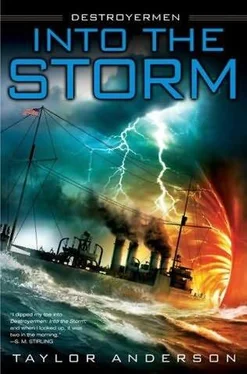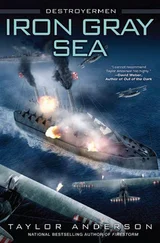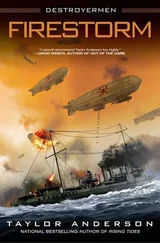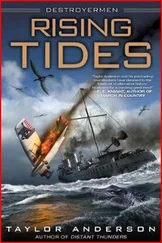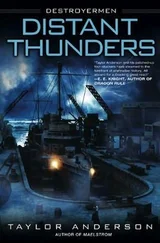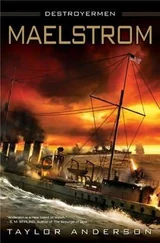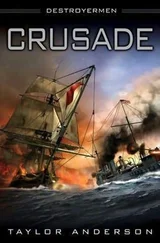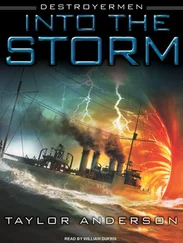She snorted with laughter, but tears filled her eyes. Without even looking to see if anyone was watching, he took her in his arms.
"I don't know what he would have said. None of my business. But I do love you, Sandra Tucker." He kissed her on the forehead. She shuddered against him.
"I love you too," she whispered into his chest. Her breath was warm through the tear-soaked cloth. "What will we do now?"
"What do you mean?" His voice was husky. "Will we win? Will we ever find other people? Will we even survive?" He raised her chin to look into her shimmering eyes. "Will this be all we ever have?" He kissed her lightly on the lips and she returned it—hard enough to electrify every nerve in his body. For a long while they just clung to one another, each drawing strength and courage to replenish the wells they'd gone to so often. Then he brushed the hair away from her face and wiped the tears from her cheek.
"Well," he sighed sadly, "that's a whole other story, isn't it?"
Far across the water, nearly a dozen men leaned against the safety chain beside the number three gun on the amidships deckhouse. There were only two pairs of binoculars among them and they were making the rounds.
"It's about damn time," Silva grumped.
"Yeah," agreed Felts. "Way to go, Skipper!"
Silva looked at Laney. "Fork 'em over, snipe." Grumbling, Laney handed him two wrinkled cigarettes—careful to keep his distance so close to the rail. Cigarettes were the closest thing to money anybody had, and nobody ever smoked them anymore. Till now. Silva handed one to Felts and lit them both with his Zippo. They took long drags and exhaled contentedly.
"What are you so damn happy about?" Laney snarled, watching his wager go up in smoke. "There's only two dames in the whole goddamn world, far's we know, and they're both took!"
Silva looked at Felts and rolled his eyes. "Snipes' brains are like weeds. Not enough sunlight belowdecks for 'em to grow." He looked at the machinist's mate. "And some are stupider than others. It's like this, see? The Skipper and Lieutenant Tucker are nuts about each other—which everybody knows, but nobody's supposed to. But they ain't gonna do anything about it until they find dames for the rest of us." He shook his head.
"Couple'a dopes. Anyway, that's a mighty incentive for 'em to find us some, don't you think?" After a moment, Laney grinned and lit a smoke of his own.
Eventually, the binoculars found their way to the Mice. No one knew why they were there. It was actually kind of cool on deck and they'd likely catch their deaths. Regardless, they waited and took their turn peering through the binoculars, one after the other. Then they shuffled off.
"I wonder," Gilbert said at last. "Maybe we could marry us one of them monkey-cat gals like Silva did."
Isak shook his head. "Won't work. Silva said the Skipper had his weddin' annealed, 'er somethin'." Gilbert looked perplexed.
"I thought `annealed' means to heat somethin' red-hot an' let it cool off on its own so you can bend it."
"Yep."
Gilbert looked at Silva and cocked his head. "Didn't work."
Every human naval vessel named in Destroyermen was real. On February 27, 1942, the old Langley —America's first aircraft carrier—was mortally wounded by Japanese planes while carrying P-40 fighters to Java. On the night of February 28March 1, 1942, Houston and Perth stumbled upon three Japanese cruisers and nine destroyers protecting a swarm of transports. Both were finally sunk after an epic fight in the Battle of the Sunda Strait.
(The only ship in the Asiatic Fleet with radar was the cruiser Boise , which had long since been sent to the States for repairs after striking a reef. The Japanese had no radar either, but they did have control of the air.)
On March 1, 1942, Pope , Exeter, and Encounter were destroyed by a combined Japanese force, including four heavy cruisers, while attempting to escape Surabaya and reach Ceylon (now Sri Lanka). Barring any mistakes that I take full responsibility for, and a little dramatic license with the pace and sequence of events, everything that took place or was mentioned to have happened in Destroyermen up to that point is true. The only exception is that Walker and Mahan were not there. Neither was Amagi .
The addition of two "four-stackers" and yet another Japanese capital ship would have made absolutely no difference to the historical outcome of that lopsided struggle. Pope, Exeter , and Encounter would have been destroyed regardless; the odds against them were simply too great. The only change to the history books (minus the Squall, of course) would have been two more rusting hulks at the bottom of the Java Sea—even before Amagi came along. But they were real.
As designed, Amagi was a thing to behold. At 47,000 tons, 826 feet long, and 101 feet wide, she was larger and more powerful than most of the battleships of her time. She would have been about the same size as the much later American Iowa -class battleships. It's possible she would have been converted to an aircraft carrier like her sisters, but she was never completed. Badly damaged by an earthquake in 1922 while still under construction, she was scrapped.
The story of Walker and Mahan is a little more involved. More than 270 "four-stacker" destroyers were built for the United States Navy during and immediately after World War I. They were built quickly (some being launched in as few as fourteen days) and were never intended to last more than thirty years—which some of them actually did. Already outdated, they remained in service throughout the 1920s and 1930s and ultimately fought in every theater during World War II.
Many didn't last that long. Because of restrictions on the numbers and tonnage of warships agreed upon at the Washington Naval Conference, many "four-stackers" languished in mothballs for years. Over time, some reentered service when an active destroyer was lost or wore out. Some were used for parts. A lot were converted into damage-control hulks or just simply scrapped. A few were even sold into the merchant service. One literally became a banana boat. Fifty were given/sold/traded to the British at the outbreak of World War II. Most that survived to fight in World War II were modified to one degree or another into minesweepers, fast transports, convoy escorts, seaplane tenders, and so on.
The point is, by the time the Japanese bombed Pearl Harbor, even the conservative, arguably moribund United States Navy knew the old "fourstackers" were obsolete, yet they used them anyway. This is not meant as criticism of the Navy—far from it. They used what they had. It was Congress that refused to build "up" even to the restrictions imposed by the Washington Treaty. It was this policy that left antique—and, in the case of the Asiatic Fleet, WWI surplus that hadn't even been altered or updated—ships to stand against the very cream of the Japanese Imperial Navy, the most modern and powerful in the world.
Walker and Mahan are presented in Destroyermen as two of these unlucky stepchildren, but in reality—the reality of the universe in which we reside—they were two of the ones that didn't make it. After sixteen years on "red lead row," Walker was slated to become a damage-control hulk, but she was scuttled seventeen days after the Pearl Harbor attack. Mahan was scrapped in 1931. Interestingly, both ships were involved in at least one epic undertaking: They served as pickets during the Navy's historic NC-flying-boat transatlantic flights. In any event, neither ship had a wartime record, so I felt less constrained in giving them a fictional, representative one.
Читать дальше
